

MAYA-GAIA INTRODUCTION & SITEMAP Page Update 08 24 07
Note: My Anthropic Trilogy web-book, evolving since 1997, is a chronicle of my passing all considered opinion through the lens of my Nirvikalpa Samadhi with both an open-mind and healthy skepticism.
geneticist using markers on the male Y-chromosome to tell the story of humankind’s history.
Human Family Tree National Geographic DVD documents the results of sampling – on a single day on a single street, in a racially diverse neighborhood in Queens, NY – the DNA of just a couple of hundred random people to create a live, dynamic genographic map of their ancestry back to their shared African origins. Excerpts highlight the immediate plight of the Hadzabe – likely descendants of the prehistoric population who actually left Africa and are ancestors of every human living on the planet today. (All images credit National Geographic DVD)
Additional Resources:
Journey of Man PBS (2003) – Mutations, or genetic markers on the male Y- chromosome, allow geneticists to trace human descent through the past 2000 generations.
Genographic Map created by the Na Geo Genographic Project.
Spencer Wells a leading population geneticist and director of the Genographic Project from National Geographic and IBM, tells a story about humankind’s history over the last 50 thousand years.
Human Family Tree – Notes on Events 150 Kya:
Advance of Ice Age causes climatic shift in Africa that starts desertification of fertile grasslands causing populations of early Homo sapiens in central Africa to disperse North and South.
 |  |
Notes on the Hadzabe:
The Genographic Project researchers have determined that some 150 Kya, a prehistoric population of Homo sapiens in the region of central East Africa, split into two migrant groups with ancestors of the Hadzabe Bushmen ranging north to Tazania and another- ancestors of the San Bushmen- ranging into northern Namibia. Although of all extant Africans, the San have the earliest Y chromosome markers for Homo sapiens- the Hadzabe are most likely the direct descendants of the small band of humans who ventured out of Africa 50 Kya to eventually populate the entire extant world population of humans who all carry the African haplotype marker.
It is possible that the earlier common ancestors from whence both the Hadzabe and San descended, made an earlier migration around 80 Kya that carried a first wave of Homo sapiens along a coastal route to the Far East. The Aeta of the Philippines, Papuans of New Guinea and other isolated populations in Southeast Asia and India with strong African physiognomy may be extant descendants of this first wave of migrants. At a site in southern India, archaeologists have dated stone artifacts ascribed (not without controversy) to Homo sapiens both above and below a layer of ash laid down 74 Kya by the supermassive Toba eruption.
 | 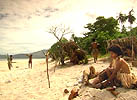 |
Hadza on the Brink by Ann Gibbons Science Magazine 18 May 2018 Summary: Times are hard for the Hadza of Tanzania, who include some of the last people on the planet to live as nomadic hunter-gatherers. Their way of life has been a magnet for researchers for 60 years, and the subject of hundreds of scholarly papers, because it may offer the closest analog to the way our African ancestors lived. A few maintain their iconic lifestyle. But their Brooklyn-size territory is being encroached on by pastoralists whose cattle drink their water and graze on their grasslands, farmers clearing woodlands to grow crops, and climate change that dries up rivers and stunts grass. Researchers wonder about their responsibilities to the people they have studied intensively for decades, and many are seeking ways to help, even as they vie to study the few Hadza who still hunt and gather full time. But some researchers have stopped fieldwork altogether, saying the Hadza lifestyle has changed too much.
The Hadza by Michael Finkel, photographs by Martin Schoeller – National Geographic December, 2009. Documentary of African aboriginal hunter-gatherer lifestyle and habitat.
Hadza (Hadzabe) People Wikipedia
Stone Age Tribe a first-hand look at the threatened way of life of the Hadzabe.
Human Food Project Anthropologist Jeff Leach is studying the Hadza in northern Tanzania, one of the last true hunter-gatherer communities in Africa. Working with a team of microbiologists in the United States, Leach wants to determine the composition of the bacteria living in their guts; he suspects the Hadza’s intimate contact with a huge variety of microbial species may protect them from certain “modern” diseases.
Tanzania: Sons of the Stone Age In northern Tanzania the Hadzabe bushmen- numbering just under 1000, with some 300-400 who may be the last Africans surviving as hunter/gatherers.
SaharaVibe Hadzabe society image library.
Hadzabe Exploitation documents the crisis over their survival- a recurrent history of ruthless exploitation of indigenous populations by “civilizing modernity”.
The Hadzabe of Tanzania: land and human rights for a hunter-gatherer community by Andrew Madsen (2000).
 | 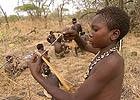 | 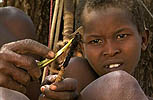 |
How You Can Help Protect Indigenous People Worldwide
International Cry (IC), founded in 2004, is an independent online journal that provides news, videos, and action alerts on the struggles of Indigenous Peoples to reclaim their lands, defend their cultures, enact their rights, and to quite literally survive.
Survival International The movement for tribal people, is the only organization working for tribal peoples’ rights worldwide. We work with hundreds of tribal communities and organizations and are funded almost entirely by concerned members of the public and some foundations. We do not take national government money, because governments are the main violators of tribal peoples’ rights, nor will we take money from companies which might be abusing tribal peoples.
Notes on The Tubu of the Sahara:
The Tubu (Toubou) live in Chad, southern Libya and Niger, among a population of over 300 ethnic groups, in some of the most inhospitable parts of the Sahara desert . The jet black volcanic peaks of the Termit range is an ecological island right at the point where the Sahara and Sahel meet that provides a rare habitable territory in their nomadic range. In prehistoric times the Sahara Desert was a wet and green area where many animals lived, including crocodiles, hippopotamuses, giraffes, and elephants. Over 30,000 petroglyph of these animals were created by the people who lived there as far back as 100 Kya. Sometime after, drought returned and lasted until another climate shift began began greening the Sahara around 50 Kya allowing new migration into the area. Their rock engravings can still be seen in many areas of the Chadian Desert. The various Paleolithic people who made these images have long since disappeared and there is no evidence to suggest that they were the ancestors of the Tubu.
However in National Geographic Magazine, June 1999 Sahara Rock Art – photos of a rock painting, 4000 years old in Libya- show one man leaning over a bowl while another carefully washes his long, thick hair – a scene common among the nomadic Wodabe. A rock engraving 9-foot high in Chad that could be seven thousand years old, represents two human figures covered with carefully inscribed, highly complex patterns- a theme that is virtually replicated in a body painting ritual among today’s Surma of southern Ethiopia.
 |  | 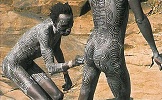 |
In fact researchers from the Genographic Project have determined that genetic markers from Tubu indicate they descend from a population previously established in the Middle East who apparently migrated back to Africa around 30 Kya when a change in climate made the Sahara region fertile. From 22 Kya, climate again shifted the monsoon rains and except for a brief greening of the Sahara 10 Kya that lasted only 5 K years, the harsh environment required the Tubu adapt to a nomadic existence.
 |  | 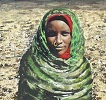 | 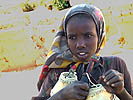 |
Tubu: the Teda and the Daza by Catherine Baroin (1997) Surveys the culture, history, and contemporary life of these two groups of African desert dwellers.
Toubou (Teda, Tubu) People North Africa (wikipedia)
Prehistoric Green Sahara There is considerable contradiction in models for human habitation and the complex chronology of the wet phases in the Sahara from archaeological evidence (Acheulean tools) and radiocarbon dating, that go back 230 Kya to the Middle Paleolithic. Generally it is thought that around 130 Kya, Pleistocene glaciation caused drought that turned grasslands throughout Africa into desert. The total population of Homo sapiens may have been reduced to a few thousand. Then as ice sheets retreated about 60 Kya, monsoon rains returned to begin a greening and human re-population of the Sahara. This ended when once again a climate shift turned the region back to desert from 22K to 10 Kya. At this time a brief 3 to 5 K year wet period ensued which allowed people from the Nile Valley and Sub Sahara- ancestors of most of the Taureg, Berber, Moors and other Saharan tribes now living there to migrate into the region. Finally, around 5 Kya, drought once again turned the Sahara into the harsh desert environment that we know today. The Tubu (Tebu, Toubou, Teda and Daza) adapted to survive all the episodes of drought and tribal conflict that repeatedly threatened their extinction over the past 30 thousand years.
Lost Tribes of the Green Sahara by Peter Gwin National Geographic Magazine Sept, 2008 – (A summary of original article) On October 13, 2000, photograper Mike Hettwer was accompanying a team of paleontologist searching for dinosaur bones in the Tenere desert in northern Niger, led by Paul Sereno of the University of Chicago. Hettwer headed off by himself toward a trio of small dunes and cresting the first slope, stared in amazement. The dunes were spilling over with bones – but they weren’t dinosaurs – they were human. Insinuated among the human bones was a profusion of clay potsherds, beads and stone tools – finely worked arrowheads and axheads. There were also hundreds of animal bones that Sereno recognized as the remains of water-adapted creatures like crocodiles and hippos, then turtle, fish and clams. Sereno realized they were in the Green Sahara. (NatGeo illustration depicts 9,000 ya Kiffian and 6,000 ya Tenerian archaic settlments.)
Notes on Tuareg Historical Ancestry:
History of Garamantes (Garamantes civilization spanned from 900 BC TO 600 AD) According to their oral tradition, the Tuareg are the direct descendants of the Garamantes. According to Herodotus in his famous work The Histories, the Garamantes were a powerful kingdom, and they were the first to introduce the Greeks to the 4 horse chariots. He also claimed The Garamantes lived further inland behind the Nasamones in the land of wild beasts. Pliny the Elder makes a mention of the Nation of Trogolodyta. Romans nominal reason for interacting with this group was for obtaining the precious stone called carbuncle. Pliny must be referring to the Tibesti mountains. In modern times the tribe called the Tubu (Tebu, Tibbu, Toubou, Tebis or Daza) also used to hunt a primitive people called Rock Tibbouu. This may have also been the Ethiopian Troglodyte that Herodotus recorded the Garamantes hunting in four horse chariots. Map of Garamantes Kingdom outside Saharan territories of the Roman empire, 2nd century AD – showing their ancient capital Garama near modern-day Jarma.
The Heritage Library of African Peoples collection of photographic portraits.
Cradle of Mankind A gallery slideshow by Joseph Lawrence (Joey L) shot in Ethiopia’s Omo Valley, featuring stunning portraits of members of various tribes that inhabit the area with cultures that are on the verge of extinction, threatened by progress and losing their language and losing their ways of life that they’ve sustained for thousands of years.
See also a somewhat related story in the Aug, 2015 National Geographic Magazine How Kenya’s Lake Turkana, a World Hertage Site dubbed “The Cradle of Humankind” as much of our species evolution over the past 4 million years happened in its environs, is under multiple threats by international oil and agri Interests that may cause its extinction. Last Rites for the Jade Sea Lake Turkana sustains the tribes in Kenya’s remote north, but projects upstream threaten its lifeblood. Nat Geo Magazine Aug, 2015 by Neil Shea. It is the world’s largest permanent desert lake and has existed in this region for some four million years, expanding and contracting in a volcanic trough along the edge of the Great Rift Valley. Ancient hominins lived along its shores, and early humans hunted, gathered, and fished here as they moved north on their slow migrations out of Africa. But Turkana, like all desert water, is vulnerable. Most of the lake’s freshwater – some 90 percent – comes from the Omo River. Now the Ethiopian government’s plans for extensive development along the river, including a massive hydroelectric dam and water-hungry sugarcane plantations, threaten to disrupt the Omo’s eons-old flow and starve the lake. In the most dire scenarios, Turkana will over the years slowly shrivel and die, turning the local population into refugees from an African dust bowl.
Anthropic Trilogy Web-Books
Web Development services by Soumya Vinod